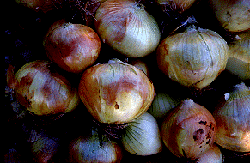NuMex Starlite

'NuMex Starlite' is a bolting-resistant, yellow grano type, short-day onion (Allium cepa, L.) cultivar developed for fall planting to mature 7 to 10 days later than 'NuMex Sunlite' and 'NuMex BR 1'. Onion harvest in southern New Mexico usually begins about June 1 and ends about September 1. Onions harvested up to July 10 are from fall-seeded, short and intermediate day cultivars, or from transplants. The Bolting tendencies of fall-seeded cultivars determine their earliest possible seeding dates, although yields are increased by earlier planting. The release of bolting resistant cultivars 'NuMex BR 1' (Corgan, 1984) and 'NuMex Sunlite' (Corgan, 1988) provided the New Mexico industry with potential for seeding earlier, thus leading to increased bulb size and yields. However, 'NuMex Sunlite' and 'NuMex BR 1' mature about June 1, providing for harvest and shipments only until mid-June. Since bolting resistant cultivars are not available for maturity dates of June 10 to 15, that maturity season is currently filled by transplants. 'NuMex Starlite' provides the New Mexico onion industry with a bolting resistant cultivar that is seeded in the fall and can fill the mid-June maturity dates.
'NuMex Starlite' was developed by five recurrent mass selections from 'Texas Grano 502 PRR' (Hawthorne, 1944). The first selection of bulbs occurred in 1978. Bulbs were selected that had pink root (Pyrenochaeta terrestris (Hans., Gorenz, Walker and Larson) and bolting resistance (PRR), late maturity, bulb firmness, and were uniform in shape. Selection for PRR was done in P. terrestris infested fields at bulb maturity. Bolting was induced by early fall planting. Bulb selection for bolting resistance was from stands that had 50 to 80 percent bolting. Tests (Tables 1,2) were at Las Cruces, New Mexico. Plot size was one standard vegetable bed, either 3.7 m (1989) or 3 m (1990) long. Experiment design was a randomized complete block with four replications. Maturity dates were recorded by plot, based on an estimate of 80 % of plants mature. The criterion for maturity was collapse of the neck tissues to the extent that tops could fall. Maturity dates in 1989 were unusually early for all cultivars, while those for 1990 are typical.
Plant characteristics are similar to 'Texas Grano 502 PRR'. Bulbs are medium deep, slightly top-shaped, with rounded shoulders and a refined neck. The level of PRR is high, and about the same as for NuMex Sunlite. 'NuMex Starlite' was 7 to 9 days later than 'NuMex Sunlite' and 'NuMex BR 1' in 3 of the 4 tests (Table 1). The bolting tendencies of 'NuMex Starlite' were similar to 'NuMex Sunlite' and 'NuMex BR 1', and significantly less than for 'New Mexico Yellow Grano', 'Texas Grano 502 PRR', or 'Texas Grano 1015 Y'. The yields of 'NuMex Starlite' were similar to those of 'NuMex Sunlite' and 'NuMex BR 1'. Suggested planting dates for 'NuMex Starlite' at Las Cruces, NM, are 25 September to 10 October. A 10 October planting of 'NuMex Starlite' following a 27 September planting of 'NuMex Sunlite', provided about 2 weeks difference in maturity between the two cultivars, ideal for continuity of harvest. Until now the maturity period immediately following 'NuMex Sunlite' has been filled largely by 'New Mexico Yellow Grano', 'Texas Grano 1015 Y' or 'Texas Grano 1105 Y', but those cultivars are susceptible to bolting, and must be grown as transplants rather than from direct seeding in the fall. Fall-seeded 'NuMex Starlite' is expected to replace much of the transplanted short-day crop in southern New Mexico.